
Homebrewing is the brewing of beer or other alcoholic beverages on a small scale for personal, non-commercial purposes. Supplies, such as kits and fermentation tanks, can be purchased locally at specialty stores or online. Beer was brewed domestically for thousands of years before its commercial production, although its legality has varied according to local regulation. Homebrewing is closely related to the hobby of home distillation, the production of alcoholic spirits for personal consumption; however home distillation is generally more tightly regulated.
Decaffeination is the removal ("de-") of caffeine from coffee beans, cocoa, tea leaves, and other caffeine-containing materials. Decaffeinated products are commonly termed by the abbreviation decaf. Decaffeinated drinks contain typically 1–2% of the original caffeine content, but sometimes as much as 20%.

Iced tea is a form of cold tea. Though it is usually served in a glass with ice, it can refer to any tea that has been chilled or cooled. It may be sweetened with sugar or syrup. Iced tea is also a popular packaged drink that can be mixed with flavored syrup such as lemon, raspberry, lime, passion fruit, peach, orange, strawberry, and cherry.

Steeping is the soaking of an organic solid, such as leaves, in a liquid to extract flavours or to soften it. The specific process of teas being prepared for drinking by leaving the leaves in heated water to release the flavour and nutrients is known as steeping. Herbal teas may be prepared by decoction, infusion, or maceration. Some solids are soaked to remove an ingredient, such as salt, where the solute is not the desired product.

Traditionally, Vietnamese tea drinking is considered a hobby of the older, more learned members in households and in society in general, although currently it has been becoming more popular in younger demographics as well. Tea drinking would accompany aristocratic activities such as composing poems, tending flowers, or simply appreciating nature. Vietnamese people generally favor lighter teas with flower fragrance, such as green tea or floral-scented white tea.
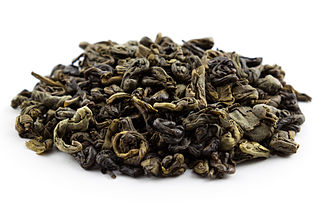
Gunpowder tea is a form of tea in which each leaf has been individually rolled into a small pellet. Its English name comes either from some resemblance of the pellets to gunpowder, or from a phrase in Chinese that phonetically resembles the word "gunpowder". This rolling method of shaping tea is most often applied either to dried green tea or to oolong tea.
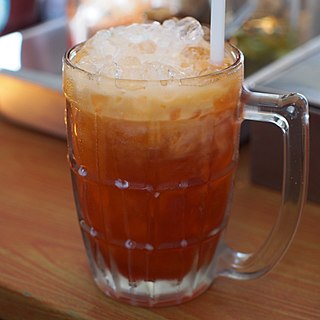
Thai tea is usually known as a Thai drink made from Ceylon black tea, milk, and sugar. Thai tea as it is consumed in Thailand is not typically brewed with spices, though many English language recipes inspired by Thai tea include ingredients such as star anise or cardamom to enhance the flavor. It is served either hot or cold. Thai tea is popular in Southeast Asia and is served in many restaurants that serve Thai food. When served cold it is known as Thai iced tea. Although Thai tea normally refers to Thai iced tea, there are also other kinds of tea which can be referred as Thai tea. For instance, the Thai traditional herbal teas which is formulated based on Thai traditional medicine can also be called Thai tea. Thai Oolong tea, which is oolong tea steamed with ginger, lemongrass, and celery, can also be referred to as Thai tea.

Shoumei is a white tea that is produced from naturally withered upper leaf and tips, with a stronger flavor reminiscent of lighter oolong teas. It is mostly grown in Fujian Province and Guangxi Province in China. Because it is plucked later than Bai Mudan, the tea may be darker in color, but it should still have a proportionate green color. Some lower grades of Shou Mei may be golden in color with many black and red leaves, making a darker brew with more depth.

The following outline is provided as an overview of and topical guide to food preparation:

American tea culture encompasses the methods of preparation and means of consumption of tea within the context of the culture of the United States.

Infusion is the process of extracting chemical compounds or flavors from plant material in a solvent such as water, oil or alcohol, by allowing the material to remain suspended in the solvent over time. An infusion is also the name for the resultant liquid. The process of infusion is distinct from both decoction—a method of extraction involving boiling the plant material—and percolation, in which water is passed through the material.
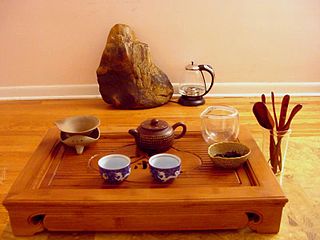
Gongfu tea or kung fu tea, literally "making tea with skill", is a traditional Chinese tea preparation method sometimes called a "tea ceremony". It is probably based on the tea preparation approaches originating in Fujian and the Chaoshan area of eastern Guangdong. The practice involves using smaller brewing vessels and a higher leaf-to-water ratio than in Western-style brewing. Today, the approach is used popularly by teashops carrying tea of Chinese or Taiwanese origin, and by aficionados and trained masters as a way to fully realize the taste of a tea selection, especially a finer one.
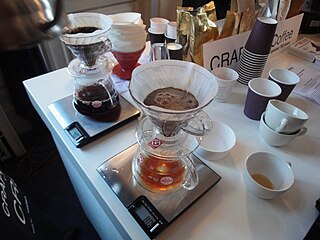
Coffee preparation is the process of turning coffee beans into liquid coffee. While the particular steps vary with the type of coffee and with the raw materials, the process includes four basic steps: raw coffee beans must be roasted, the roasted coffee beans must then be ground, and the ground coffee must then be mixed with hot or cold water for a specific time (brewed), the liquid coffee extraction must be separated from the used grounds, and finally, if desired, the extracted coffee is combined with other elements of the desired beverage, such as sweeteners, dairy products, dairy alternatives, or toppings.
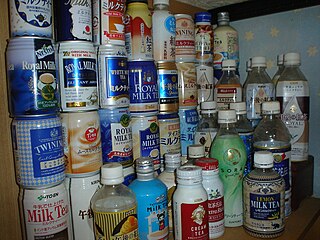
Canned tea is a relatively recent method of marketing tea which has been sold traditionally as leaf tea and also, for the last 100 years, in tea bag form. It utilises the canning process to produce a ready made drink. Perceived advantages includes ease of use and the possibility of additives ; the disadvantages are the cost of shipment and a lack of freshness.

Coffee cherry tea is an herbal tea made from the dried skins and/or pulp of the fruit of the coffee plant that remain after the coffee beans have been collected from within. It is also known as cascara, from the Spanish cáscara, meaning "husk". It is similar to a traditional beverage in Yemen and Ethiopia. Starting about 2005 it was independently developed and promoted for export by Salvadoran coffee farmer Aida Batlle. The dried whole fruits are also eaten like raisins.

Cold brew coffee, also called cold water extraction or cold pressing, is the process of steeping coffee grounds in water at cool temperatures for an extended period. Coarse-ground beans are soaked in water for about 12 to 24 hours.
Jun, or Xun, is a fermented drink similar to kombucha, differing only in that its base ingredients are green tea and honey instead of black tea and cane sugar. Jun is brewed by fermenting green tea with a symbiotic culture of bacteria and yeast (SCOBY). Fruits, sweeteners, spices, and other flavor enhancers are also commonly added to make the taste of the beverage more appealing. Though Jun bears similarities to other fermented drinks like kombucha, water kefir, and kvass, it has enough differences to be considered a distinct drink.
Cold brew generally refers to:

Arabic tea (Arabic: شاي عربي, romanized: šāy ʿarabiyy, (pronounced shay, is a variety of hot teas popular throughout the Arab world. It is commonly served to guests and business partners at meetings and social events, and has been drunk by Arab people for centuries.
















